IPM 5 Fighting Varroa : Biotechnical Tactics Part 2
IPM 5 Fighting Varroa
Biotechnical Tactics 2
The One-Two Punch
Randy Oliver
ScientificBeekeeping.com
First Published in ABJ in May 2007
Introduction 1
Drone Brood Management and Trap Combs 1
Powdered sugar dusting 4
The Oliver 15-second sugar dust method 6
Discussion 7
The one-two punch—30 seconds to knock out varroa! 7
My new website 8
References 8
Note: this article is broken into two web pages. Powdered sugar dusting details are on the next page!
Introduction
None of the biotechnical methods that I detailed last month will control varroa alone. Now it’s time to give you some real meat! Either of the two methods I’m about to describe, used alone, have been tested and proven to keep varroa at tolerable levels if performed properly. Used together, they may be a nonchemical one-two punch that will give us the upper hand on the mite.
A note to those commercial beekeepers who are saying, “Jeez, this guy is totally whacked out! I’m already maxed out for time, and can’t be putting special labor-intensive gizmos into my hives—that’s for hobbyists. Plus, I can’t take a chance on trusting my mortgage on some untested mite control method.” In answer, my California son would say, “I feel you, man.” I’ve got two groups of beekeeping friends—hobbyists who are willing to test new things on their handful of colonies, and commercial guys who run very efficient operations by rotating a series of ag chems. What I’ve been seeing the past few years, are hobbyist/sideliners maintaining strong colonies without any synthetic miticides. I was skeptical as hell at first, but they’ve demonstrated the feasibility. As with any historical change in an industry, the majority says, “It can’t be done, we can’t afford it, it won’t work in reality.” Then, several years later, they look back and see that it was done, the industry could afford it, and it did work in reality.”
Drone Brood Management and Trap Combs
The first punch that we’re going to hit the mite with is based upon the fact that varroa reproduces rather poorly in worker brood, but is nearly three times more successful in drone brood, due to its longer postcapping period. It’s not surprising then, that female mites prefer drone brood by a factor of roughly 10 to 1 (reported figures range from 4:1 – 12:1). The mites, being tiny and blind, apparently recognize nurse bees by odor (Dillier 2004), and ride around on them until they smell a drone larva of the right age. Since nurse bees spend much more time feeding drone larvae than worker larvae (Calderone & Kuenen 2003), the mites have ample opportunity to come into contact with drone larvae.
A feral colony of bees builds about 17% drone comb (Seely 2002). Rapid mite reproduction in this amount of drone brood largely accounts for the decimation of the feral bees by the mite. The stimulus to build drone combs is good forage (at any time of the year), with a negative feedback from drone brood already existing (Charriere, et al. 2003). Beekeepers, by using worker-sized foundation, can typically keep drone cells down to about 4% if they regularly cull old combs. However, colonies will normally produce temporary drone cells in the space between the brood chambers in spring. Indeed, a quick inspection of the exposed drone brood when you break the brood chambers apart can give you an indication of varroa infestation level.
The beekeeper practicing varroa IPM can minimize varroa reproduction by managing the amount of drone comb in his colonies. This is especially important since hygienic bees remove only infested worker pupae, not drone pupae. I’ve already mentioned the importance of culling old combs with drone cells. Wilkinson and Smith (2000, 2001) modeled the effects of drone brood management. They state: “At 5% drone brood, as many mites are emerging from 50-60 drone cells as from 1000 worker cells. This certainly emphasizes the importance of drone brood in mite population growth, and the need for beekeepers to prevent large quantities of drone brood being reared unnecessarily and being left to emerge in the hive.” They suggest “regular and ruthless ‘culling’ of the old combs and the badly built combs.” Their model predicted that reducing drone brood from 4% to 3.2% would reduce the mite population growth rate by 25%! They suggest that drone brood is more important to mite growth at low mite levels, since drone brood capacity for mites reaches its limit before that of worker brood.
Clearly, the beekeeper should cull frames containing drone comb. However, we can go even a step further, and use drone comb to “trap” mites, and then remove those mites from the colony. This process is called “drone comb trapping,” and is widely used with great success in other parts of the world. The concept is simple: insert a frame of drone comb into a colony at the edge of the brood nest, allow the queen to fill it with drone eggs, wait while the mites infest the cells, then remove the frame before the mites emerge. Theoretically (Wilkinson & Smith 2002), trapping with one deep drone frame once a month for four months will delay the mite population from reaching a damaging level for 2-4 months; two frames monthly will delay it for a year.
So, you ask, theory is fine, but how effective is drone trapping in real life beeyards? The short answer is, surprisingly effective! Dr. Nick Calderone has an excellent guide at http://www.three-peaks.net/PDF/Drone%20Brood%20Removal%20for%20the%20Management%20of%20Varroa%20destructor.pdf. In his study (Calderone 2005), two combs were replaced monthly from June through September. Mite levels were kept to about 2.5% (ranging from 0-7%)—up to 10 times less than control colonies! The drone-trapped colonies also made more honey!
In Europe, Charriere, et al. (2003) report that drone trapping has no negative effect on the development of the colony and honey production. In their tests, which used the equivalent of one drone frame per colony, removed regularly, they found varroa buildup was suppressed enough that only a fall treatment with a natural chemical was required.
Drone trap combs clearly work, but are they practicable? For the hobbyist, the green plastic drone combs available from several bee catalogs are great. You put them in, wait exactly four weeks (a few days until the queen can lay, then 24 days for the drone development period) and remove them. The brood and mites can be killed by removal with a cappings fork, scraping, freezing, heating, or treating with formic acid. The combs are then replaced for another cycle. Reusing drone comb may have the added benefit, that it might be more attractive to mites. In an experiment where old combs were placed side by side with new combs in colonies of Brazilian AHBs, Piccirillo and DeJong (2004) found that cells of old combs were four to five times more attractive to varroa than same-sized cells on new combs. The authors concluded, “It is clear that these mites strongly preferred old worker brood comb cells to new worker brood cells.” Drone cells were not tested, but this avenue calls for further study.
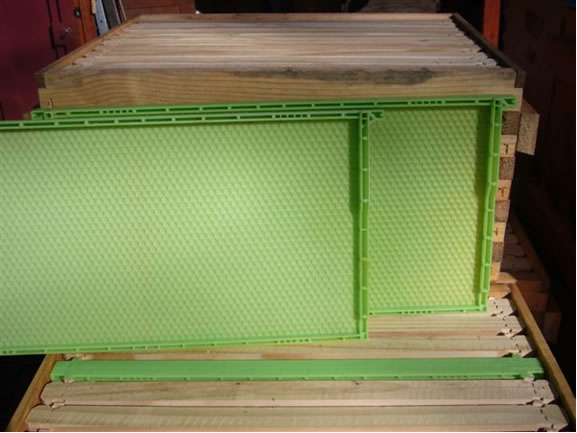
One doesn’t need to purchase plastic trap combs. A medium frame, a deep frame with a section of comb cut out, or even a foundationless frame, will allow bees to produce volunteer drone comb, which can be cut out and discarded (or melted for the wax).
For the commercial beekeeper, it’s obvious that an extra piece of equipment, or the concept of freezing combs is impractical. Also, reaching down to remove broken-off pieces of drone comb built on the bottoms of frames would be too time consuming. To address those issues, I designed and tested a dedicated trap comb that can remain in the hive all year. I knew that the bees would store honey at the top of a comb, so I made a provision for that. I also wanted a wooden rim all around the drone brood so that I could quickly cut the comb out with a hive tool in the field.
I also knew that mites only enter drone cells on days 8 and 9. Therefore, each cell only has a two-day trapping window. Once a cell is capped, it can no longer trap mites. Ideally then, to ensure continuous trapping, one would want the queen to lay eggs progressively on the trap frame from the time it is inserted, until 9 days before it is removed. Therefore, I wanted to force the queen to lay progressively by making the bees build their own drone comb from scratch.
See the photo for the design of the Oliver Trap Frame. I simply take ordinary deep frames, and an extra top bar. I cut the ends off the top bar and install it upside down, slipping it onto a piece of plastic worker foundation ripped down to 2½” (Permadent® fits in the grooves better than deep cell foundation). There is a little over 2” of foundation remaining exposed at the top of the frame. This design works great! We tested 300 of them last year. Virtually every colony builds them out as illustrated—honey in the top, drone brood below (do not increase the 2” foundation dimension, or some colonies will produce worker brood above. We may wish to even decrease this dimension—let me know if you try).
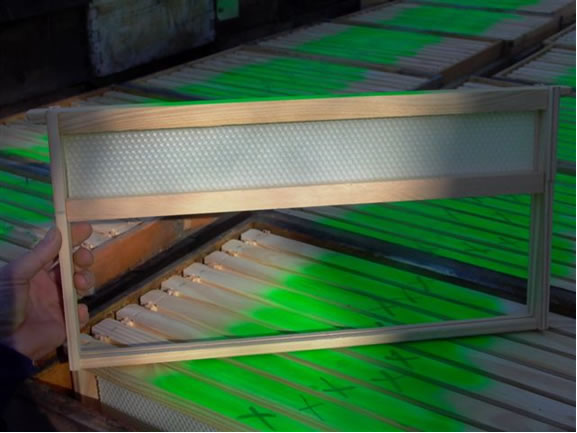
The Oliver drone trap frame.
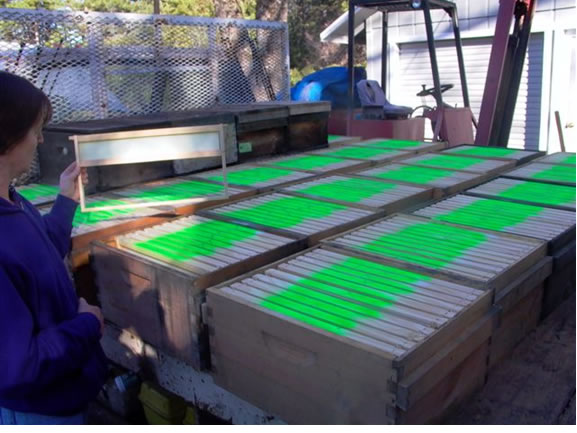
Stephanie loading new trap frames. We tested 300 last year.
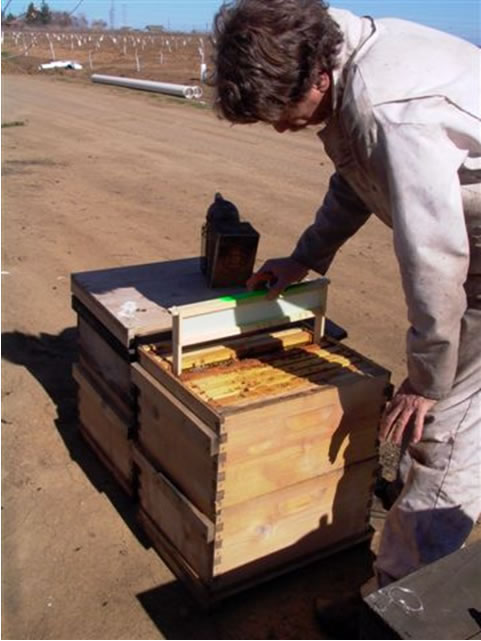
Inserting a trap frame in the almonds for an early start.
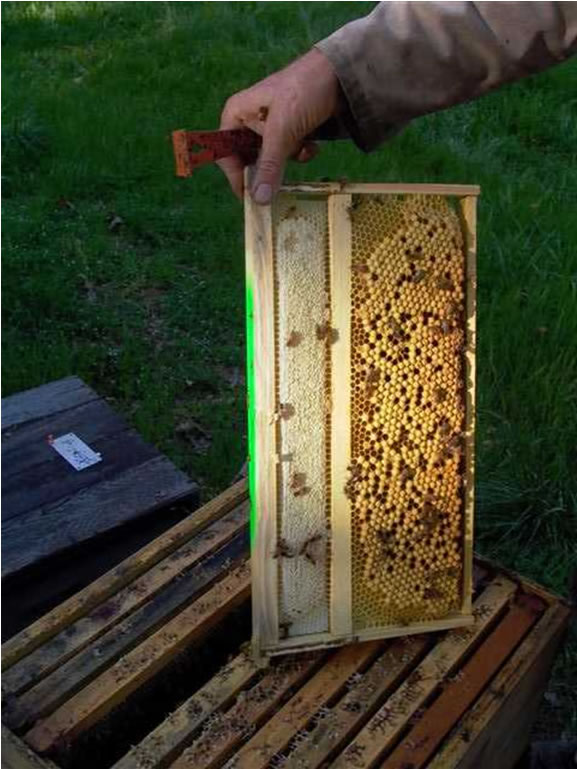
Drone trap frame at four weeks—honey at top, drone brood below.
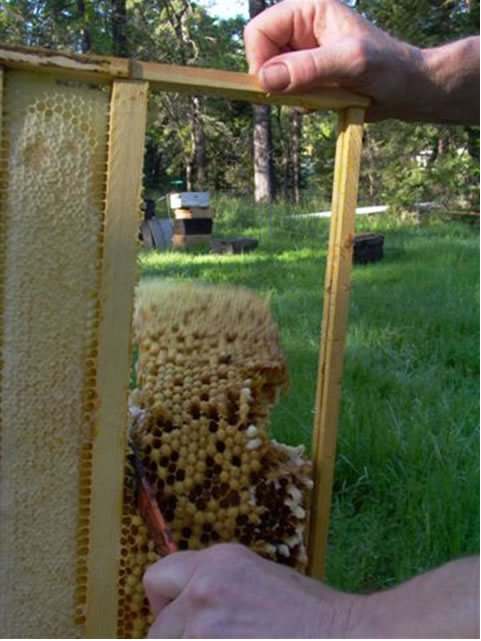
Cutting out the drone comb with a hive tool.
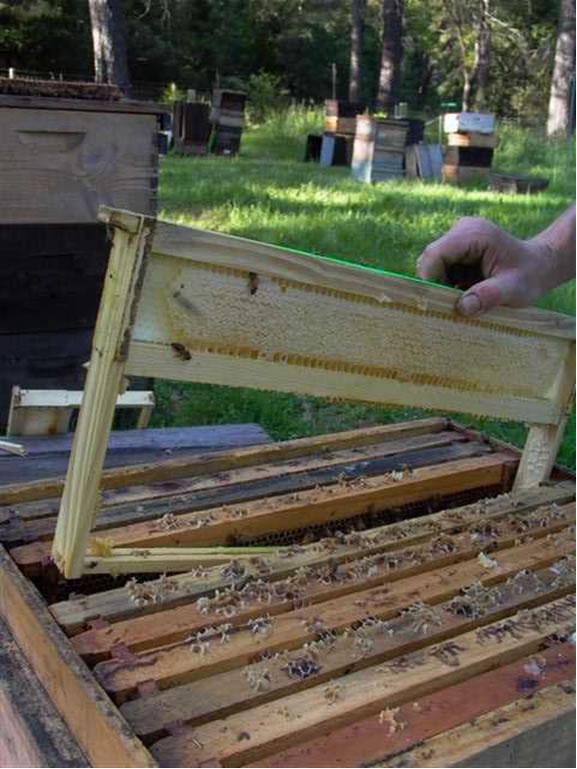
Reinserting the frame for the next round of trapping. The bees will quickly build new comb on the remaining wax. The whole process takes only 15 seconds!
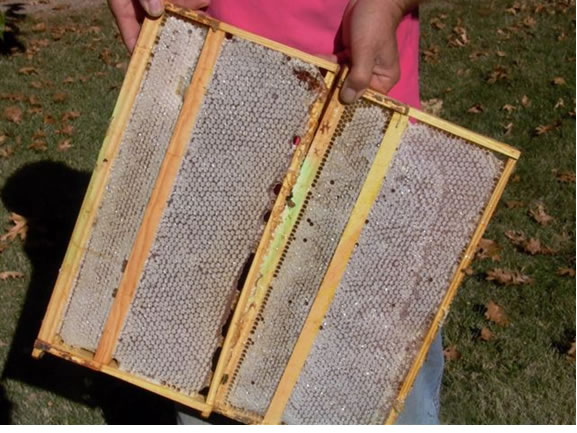
Trap frames set to edge of brood chamber for comb honey production in bottom half.
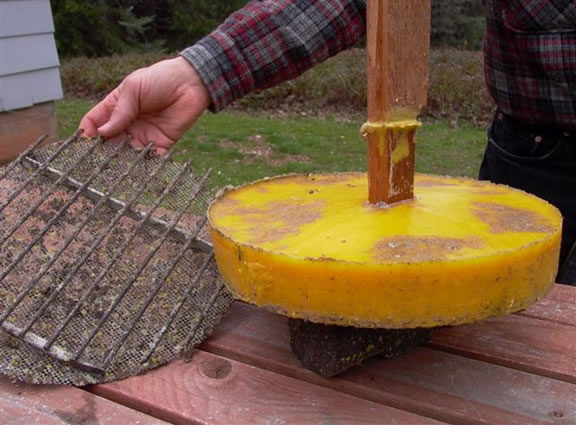
Pure beeswax extracted from cut out drone combs. Less than an ounce per comb, but this wax can be sold at a premium, as it is completely pure and chemical free.
Here are the advantages of this design:
1. It takes only about 15 seconds per colony to open the lid, remove the comb, cut out the drone comb with your hive tool, replace the frame, and close the lid. It’s so fast that we don’t even close the door to the truck when we hit a yard! No freezing or extra work is required.
2. Since the bees must build comb from scratch, the queen can only lay so many drone eggs per day. This restraint extends the period that the combs are actually trapping mites.
3. Since the combs are returned to the same hive, there is no spread of disease from colony to colony.
4. When you are done with drone trapping for the season, move the comb to the outside of the cluster to produce comb honey for sale or winter stores.
We found that colonies with drone trap frames tended not to produce drone comb between the boxes. This observation is supported by Seeley (2002), who found that colonies with added drone comb build 7½ times less volunteer drone cells as those provided with 20% drone comb. So by adding drone comb, you actually remove the incentive for the bees to produce drone cells elsewhere in the colonies. In effect, drone trap frames allow you to manage drone production in your operation. Indeed, in our queen rearing operation, by removing the unwanted drones from poor queens, and by leaving extra drone combs in our drone mother colonies, we produce an excess of genetically superior drones for mating, while suppressing the population of genetically undesirable drones. Since we breed for mite tolerance, our drone mothers have fewer mites to start with, and the extra drone comb is less of an issue for mite buildup.
You may ask whether it is worthwhile to extract the wax from the cut out drone comb. We boiled 200 cutouts, and produced 10 lbs of wax. We found that it wasn’t worth our labor, so we now just feed some drone brood to the chickens, and compost the rest for the garden. If you had a better means of extracting the wax, you might be able to reclaim it. Or, you might find a market for it as livestock or pet feed, or sell it in Asian markets as a delicacy!
As I mentioned in the previous installment, using these combs in conjunction with queen restriction can nearly completely eliminate varroa from a colony (Calis, et al. 1999).
Zachary Huang is developing the Mitezapper—a drone trap frame with heating wires in the foundation. Once a month, the beekeeper would hook up wires to a car battery for a few minutes to kill the mites with heat. The colony would not even need to be opened!
Hoopingarner (2001) does raise one potential objection to trapping with drone brood: “it exerts constant selection against the mites that prefer drone brood. This is not in the long-term best interest of a varroa reduction program” because, it de facto selects for mites that prefer worker brood. However, upon further reflection, Charriere (2003) states, “The often expressed fear that removal of drone brood will select for a population of varroa that prefer worker brood does not seem to be justified. We should remember that the removal of drone brood occurs only during a short period, and for the rest of the year the mites are obliged to breed in worker cells.” Indeed, if we breed for varroa sensitive hygiene, the mites don’t stand a chance in worker brood.
Make sure that you read the updates to the end!
Updates 12/6/2010
French study: Efficacy of drone trapping four times in a season. Kept mite levels substantially (25%) lower, but still needed additional control measures. Honey production did not suffer as a result of trapping. Unexpected result was control of swarming!
(Broken Link!) http://www.bas-rhin.chambagri.fr/kitPublication/fileadmin/documents/Elevage/Apiculture/D%C3%A9coupe_du_couvain_male_-_experimentation_de_son_%C3%A9fficacit%C3%A9_-_CRA_2010.pdf
California beekeeper Jeremy Rose reports: I did a few drone comb removal cycles on 130 hives this past spring, before the honey supers became too heavy to lift. I don’t know that I noticed reduced swarming this year (30% of my hives swarmed even though they had been split!), but I did catch the hives that wanted to swarm before the swarms actually left (helpful so that I knew to get them a new queen the following week). It was easy to see, since the drone frames would always have swarm cells on them. Hives that were not getting ready to swarm would have some cells of fresh eggs in the drone comb which made non-swarming hives easy to distinguish (I took partially-full supers off hives that were preparing to swarm and gave them to the non-swarming hives).
Bottom line:
Drone brood trapping works great, and can be done very quickly and cheaply. It doesn’t decrease honey production, and keeps the bees from building volunteer drone cells elsewhere. It may keep mites below economic injury levels alone, but will likely require supplemental treatments.
Points to remember:
1. A full comb removed monthly will generally keep mite levels below threshold.
2. Two full combs would be even better.
3. Two combs, alternately removed every other week, would likely be best.
4. Do not forget to remove the combs at 4 weeks, or you’ll be breeding mites!
Update 12/25/08
Drone trap frames left unmanaged in position 4 in the upper brood chamber in my California/Nevada bee management are used heavily in spring and early summer. Later in the season, the bees may fill them with honey, or they may make a mix of drone brood of uneven age with honey interspersed. Surprisingly, I find that in those colonies in which I accidentally left the drone frame in the broodnest (instead of moving it to the side) didn’t appear to have much different mite levels than those adjacent colonies whose frames I had moved.
I’m trying to get a feel for the value of drone trap frames. The one property of them that stands out to me is that they can be used to “manage” where the bees place drone comb in the colony, by giving them a place to build it.
It may be that a partial frame of drone brood, as in my trap frames, may satisfy the colony’s desire to build drone comb and raise drones, thus eliminating most volunteer drone brood elsewhere. It may also be that we might be able to strongly affect varroa buildup with only one or two removals of the patch of drone brood at an appropriate time.
The question would be to determine the best time. I know that the first round of drone brood in my colonies (after winter oxalic dribble) contain almost zero mites, so removal at that time would only waste colony resources. This is also the generation of drones that mate with my raised queens. Drone brood removal at that time is of value to me as a way to eliminate drones from poorly-performing colonies from mating with my new queens–it allows to manage the genetics of the matings.
Later in the season, it may be appropriate to simply monitor the drone brood with a fork, during normal colony inspections (although this method as an indicator of mite population in the colony has been shown to be unreliable), and to cut out the drone brood when you see a significant mite infestation within.
The question for this strategy would be: Under what circumstances does the benefit of removing the mites in a frame of drone brood outweight the cost for the bees to replace it? If you have experience with this method, let me know your results.
Update 4/27/2011
This season we were not able to get our drone frames into our hives when we went to almonds. Boy, did we notice a difference when we split the hives when we came home! Since we started using drone trap frames, we had gotten used to seeing very little reworking of worker comb into drone comb on the brood frames. Without the presence of the drone frames in the hives, the bees reworked large patches of worker comb into drone comb. The effect, although not done as a controlled trial, was clearly noticable to all of us. Could be a fluke, but I doubt it.
At this point in time, I really like having a drone trap frame in each hive year round, as it “manages” exactly where bees will build drone comb. I then simply use a cappings fork to check the mite levels in the drone brood to see whether it is worth cutting it out.
Powdered sugar dusting
The second punch in our combination came from Finland. A few years ago, I came across an article in ABJ by the Finnish researcher, Dr. Kamran Fakhimzadeh (2000). He had been looking at various materials for dusting bees, with the intent to cause increased drop of the phoretic varroa mites. He hit upon powdered sugar as being both non contaminating to honey, and just the right size to clog up the mites’ feet. Pettis and Shimanuki (1999) had already proposed using dust in conjunction with a screened bottom board for varroa control. I mentioned the articles at our local bee meeting. One hobbyist member, Janet Brisson, was taken by the possibility of using sugar dusting and screened bottoms for mite control, and became a proselytizer for the method. I found the concept to be of interest, but the time-consuming method by which she and others went about applying the dust seemed totally unpractical to me.
Last year, at the club meeting, I asked for a show of hands as to what methods members were employing to control the mite. I was surprised that the majority were using sugar dusting! Finally, after seeing the method apparently being successful for two years, and reading Jerry Hayes (2004) promote the “Dowda” method in The Classroom, I felt that I needed to give sugar dusting a second look!
I did a few tests. I saw that sugar dusting sure did cause a lot of mites to drop, but it didn’t appear to affect subsequent stickyboard counts much, even after two weeks of repeated dustings! Something didn’t make sense. How could this method work if it didn’t affect sticky counts?
Then I started researching mite population dynamics, and realized the error of my thinking. Mites are only phoretic for about 5 days during broodrearing (a range of 4-15 days, dependent upon a number of factors (Harbo and Harris (2004)). Therefore, one would expect about a 20% turnover of phoretic mites every day, as older ones reenter brood cells, and new ones emerge. Knowing this, even if you had some new wonder chemical that killed 100% of the phoretic mites one day, you’d still have a 20% return of the phoretic mite population the next day, 40% by the second day, and back to the pretreatment level within a week! If you were to take a stickyboard count a week after the 100% kill, you would see zero effect from the dusting!
What I realized was that the problem wasn’t that sugar dusting didn’t work, but that I was not measuring its efficacy the right way! So I looked to the literature for measured levels of efficacy of an in-hive sugar dusting. To my surprise, there weren’t any. Fakhimzadeh had only measured the increase in daily mite drop and Aliano and Ellis (2005) had recorded a 75% mite drop only from caged bees. I contacted every researcher and beekeeper I could for an in-hive efficacy figure, but no one had one. So I collected the hard data myself, by dusting three test colonies (one, two, and three story), measuring the mite drop for the first hour, and then sacrificing all the bees in the colonies and washing the mites from them. I will write up a full version of the results when we complete testing, but in short, about a third of all phoretic mites in a colony drop in the first hour after dusting!
I now had a figure that I could use for crude modeling of the effect of repeated sugar dusting on mite population growth. I wanted to see if a mathematical model based upon the mite kill rate I measured would reflect the reports from the field. Since Fakhimzadeh and other beekeepers report that mites continue to fall at an increased rate for over 24 hours, I made the assumption that a good sugar dusting would kill 50% of the phoretic mites—a round number based upon a 33% initial kill, plus an arbitrarily assumed half again residual kill. These are working numbers subject to revision when we obtain more data.
Let me be clear at this point. I’m not about to recommend any varroa control treatment based upon mathematical modeling. What I’m curious to see, is whether the amount of mite drop caused by powdered sugar dusting could be mathematically expected to effect the mite control claimed by its proponents. So I called around to those who have been using the technique for over two years, and asked them for their records and observations. Some dusting practitioners had used ancillary treatments, such as drone brood trapping, or essential oils, so I allowed for those treatments. Their records indicated that: Initial dusting once a week for several weeks knocks mite levels way back, dusting twice a month keeps the mites at low levels, and dusting monthly (or even less frequently) keeps the mites at tolerable levels.
So, let’s see if crude mathematical modeling supports the field experience. I set up a simple mite population growth curve based upon a starting population of 100 mites, and a reasonable 2.4% daily mite growth rate (Martin 1998). Then I killed 1/6 of the total mite population at each dusting, based upon killing half of the one-third of the total mite population that is phoretic at any given time during the treatment period of March 1 through September 1. This model is very crude, and doesn’t account for amount of drone brood, multiple infestation, or other variables, and should only be used to give us a rough idea of the feasibility of the technique. I must admit, the results surprised me in how closely they reflected field experience! Clearly, powdered sugar dusting as a mite control measure has proven field efficacy, plus a mathematical model to support it.
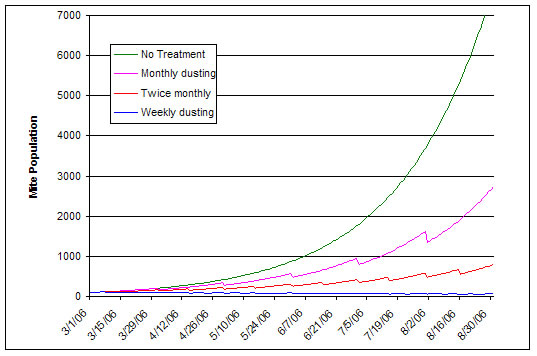
The estimated effect of powdered sugar dusting over a screened bottom on mite population growth, based upon a starting population of 100 mites, a daily growth rate of 2.4%, and an estimated kill of 50% of the phoretic mites per dusting treatment. Note that weekly dustings would result in a decrease in the mite population. These curves are based upon very crude math, and are only for general illustrative purposes, although they confirm field experience.
Note that the control curve reaches a devastating mite level by September 1st. Monthly dusting in this model keeps the mite population below a moderate threshold of 3000 mites, and bimonthly dusting keeps ‘em below 1000—a load that is considered acceptable by most all authorities. The weekly dustings actually decreased the mite population over the treatment period.
Not only that, but the illustrated curves likely underestimate the effect of sugar dusting, since even though it effectively kills only a sixth of the mites, the mites killed are those that would have been most likely to survive to reproduce. That is, once a mite is in the phoretic stage, its natural mortality rate is very low—about 0.6% (6 out of 1000) per day, as compared to the 20 –30% mortality of those first emerging from cells (Martin 1998). Although about two-thirds of the mites are under cappings and thereby protected from dusting treatments, that proportion is tempered by the fact that a quarter of them will not survive through emergence. This makes the mortality of the phoretic mites more important than their proportion might indicate. Recall from my discussion of mite population dynamics that that a female mite needs to average 2-3 reproductive cycles for varroa populations to grow at the pace that we see in the field. If sugar dusting knocks a mite down early in her life, she will be unable to complete multiple cycles. The surprising effectiveness of sugar dusting may due to its impact on the average number of reproductive cycles that a mite can complete.
The Oliver 15-second sugar dust method
Before I even considered advocating sugar dusting, I knew that no one with more than a hive or two would be out there using the suggested application methods of flour sifters or squeeze bottle puffing. It was far too time consuming! So I bought 50 lbs of powdered sugar from my local baker (it’s cheaper that way) and set out to see if I could come up with an easier, quicker method. I did.
The method:
Materials:
1. A 5 gal bucket with a screw top lid to hold the fine confectioner’s sugar. Hobbyists can use any airtight kitchen container. Large operators may wish to use a rectangular plastic waste basket on a caddy that also holds the screen.
2. A bee brush with a 1-cup measuring cup taped to the handle (large operators will need a cup with a strong handle). Fluffing the sugar once by tipping the bucket will make it much easier to scoop.
3. A wood-rimmed moving screen of (strong) steel window screen. The rim should be ¾” on the top side (to contain the sugar), and at least 3/8” on the other (to space the screen above the top bars). I used 1/8” hardware cloth at first—it’s faster to sift, but doesn’t do as good a job at breaking up the lumps of sugar.
4. The colony should be on a screened bottom (I’m assuming this, but have not tested to see if it’s truly necessary).
Technique:
1. Smoke the colony.
2. Remove the cover and smoke the bees down off the top bars.
3. Put the moving screen over the frames, and then use the cup to spread powdered sugar on the screen over the cluster area. Use 1 cup (approx. 100g) for 1-story colonies, or 2 cups for double deeps.
4. Flip the brush around, and use it to sift the sugar through the screen.
5. Lift the screen, and continue to use the brush crosswise across the top bars to sift the sugar into the beeways.
6. Replace the cover. We do this entire operation handily in less than 15 seconds!
7. Mites will begin to fall within seconds. If you’ve put a dry stickyboard under the screened floor, you can get a good indication of your mite level in an hour.
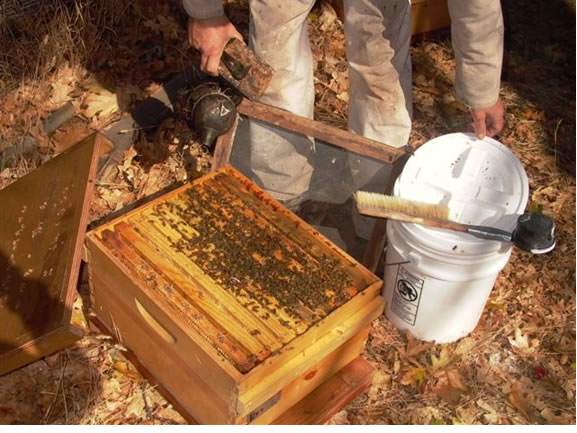
Tools for the Oliver 15-second sugar dust. Note the cup duct taped to the brush handle as a time-saving measure. Window screen in wooden frame.
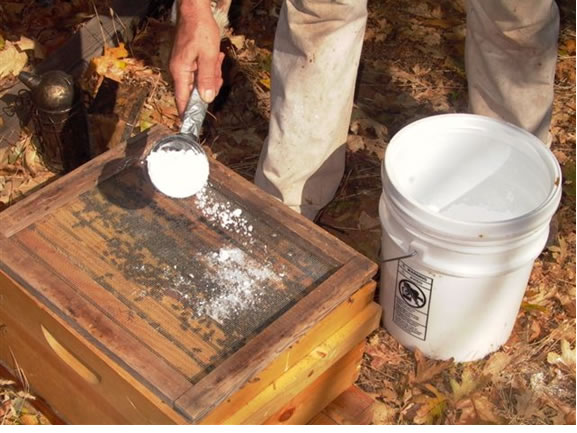
Use one cup of sugar for singles, two cups for doubles.
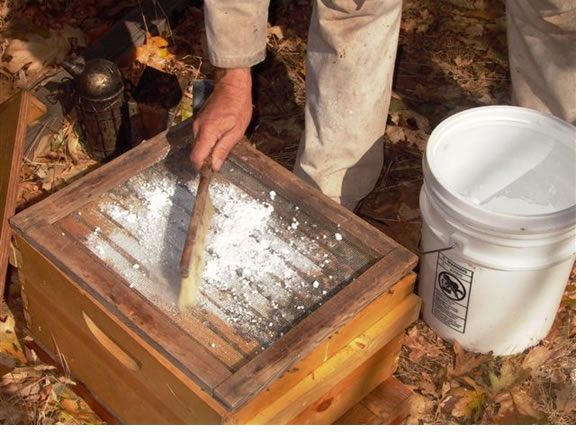
Brush the sugar through the screen over the cluster of bees.
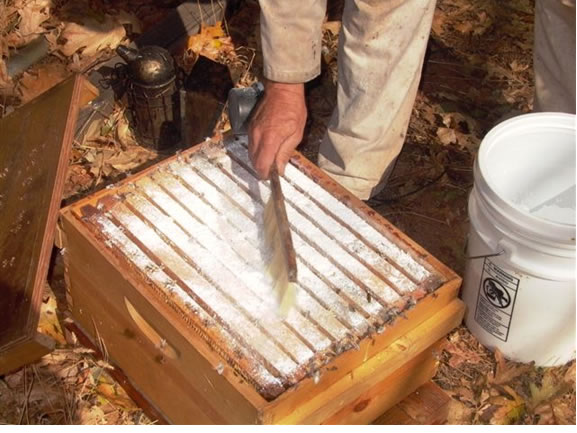
Lift the screen, and brush the sugar crossways across the frames so that it all falls on the bees. The whole process takes less than 15 seconds!
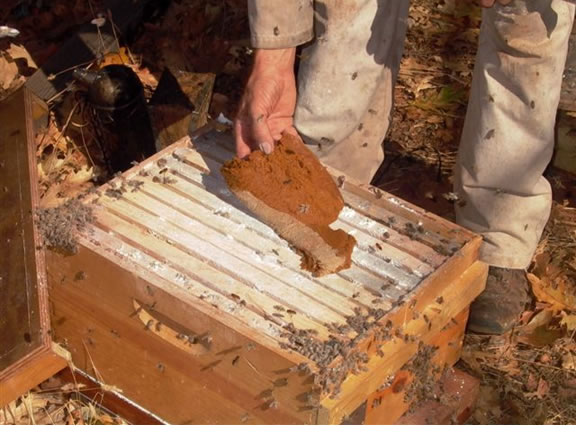
Kill two birds with one stone by combining dusting with other hive procedures. Feeding pollen supplement here.
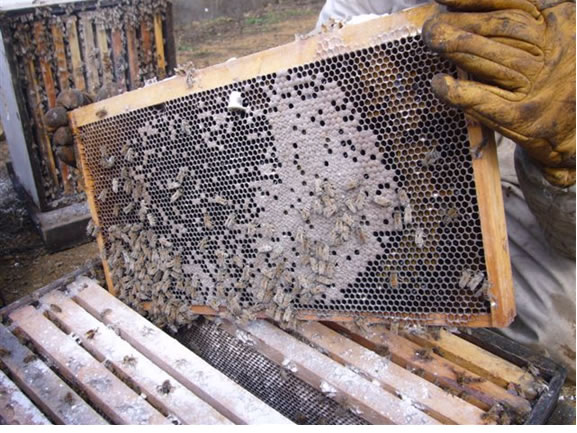
This is a frame from the bottom brood chamber of a double, two minutes after dusting the top bars of the upper box with two cups of sugar. Note the sugar that has fallen through onto the top bars, and onto the bees and combs.
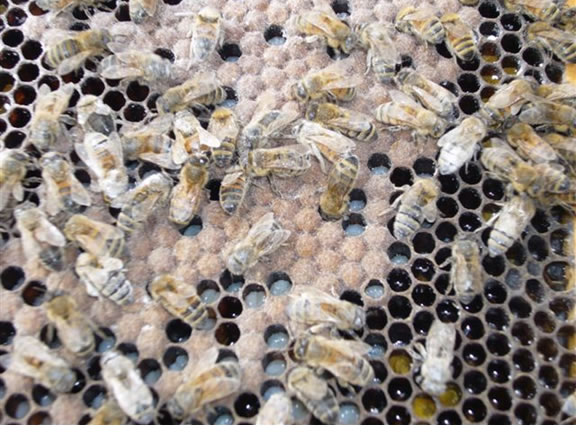
Close up of the bees from the frame in the previous photo. Note the sugar dust on their bodies, even though we dusted the box above.
Tips:
1. In this case, more is better. Use enough sugar so that some falls through the screened floor.
2. Test your technique by pulling frames of bees from the bottom box in about two minutes. They should be obviously dusted white.
3. Keep yer powder dry! Damp powdered sugar clumps too much to dust the bees efficiently. Store it in a warm, dry place.
Discussion
OK, sugar dusting has a proven track record, a mathematical explanation for its efficacy based upon mite population dynamics, and can be done quickly and cheaply (less than 25¢ to treat a 2-story colony). Why does it work, and will it harm my bees? Luckily, this question has largely been answered, both from practical experience, and scientific research. Sugar dust adheres to a mite’s ambulacra (foot pads) (Fakhimzadeh 2000), apparently causing the mite to lose its grip on the bee. Dusting may, in addition, stimulate bee grooming behavior (Macedo & Ellis 2002). It is a mechanical method of mite control, rather than chemical. It does not directly kill the mites—they fall out of the hive and can’t return. Fakhimzadeh (2001) found that direct heavy dusting resulted in greater mite drop than light blow dusting, and that no sugar particles were found in the bees’ trachea (breathing tubes). Heavy dusting may cause significant egg removal, and loss of a fraction of the older larvae (Aliano & Ellis 2005). This loss would be of little consequence, since a portion a day’s quota of eggs represents a relatively minor investment to the colony. Fakhimzadeh (2001) also found that dusting at frequent intervals did not appear to affect brood production, colony strength, queen survivorship, or honey production. Note that he dusted with less sugar 15g (about 1/8 cup per colony) than is currently recommended. His control of mite buildup was also less. I have not heard reports of problems due to dusting with 2 cups per colony.
There are drawbacks to sugar dusting. First, its application is dependent upon fair weather. It may also draw ants. Janet Brisson reported that sugar dusting during a nectar dearth may initiate robbing. I suggested that she try the old trick of removing all the hive covers in the apiary when you begin. That stopped the robbing problem. The question has arisen as to the best time of day to dust. I don’t know. Most mites hang out mostly on younger bees around the brood nest, so it may not be important to dust all the foragers. We still have lots to learn!
Some practitioners suggest banging the side of the hive after application to dislodge the sugar and stir up the bees. This makes sense. I’ve had an additional brainstorm: I’ve figured out how to effectively infuse powdered sugar with menthol, in the hope that it will agitate the mites, and cause more to drop. But first I need to test it to see if it kills brood. I’ll keep you posted on the results.
The beauty of sugar dusting is that you can do it as often as needed to control the mite. If your bees pick up extra mites from collapsing colonies, hit ‘em with sugar. Use the “Shoot first and ask questions later” method of dusting and taking a mite sample at the same time with a stickyboard (it doesn’t need to be sticky if you use enough sugar so that it falls on the board). If you see a lot of mites, dust weekly; if there are few mites, wait a month. When your colonies are broodless, a few sugar dustings would be expected to knock the snot out of the mite population, since they are all exposed to sugar at that time. I’ll try to get some numbers next winter.
I have been corresponding with the California Department of Pesticide Regulation. I explained how sugar dusting (and grease patties for tracheal mite control) were used, and asked them for an opinion as to whether they would be considered as pesticides, and therefore subject to regulation. Their response was:
“Randy, the two products of discussion are food products that are
normally consumed and have labels that do not make any pest control
claims. The way you are using them is to either create a barrier to the
mites or mask the smell of the bees so the mites won’t be attracted to
them. These actions are usually not thought to be methods of pest
control that need to be registered. These are like home-remedies. As
long as the food product labels do not make any pest control claims
like kills, controls, repels, etc. mites in bees, these are not
pesticide uses and do not have to be registered.”
Bottom Line
Surprise—powdered sugar dusting really kills drops a significant proportion of the phoretic mites, and that exerts a strong effect on mite reproduction. It’s safe, doesn’t hurt the colony, can be used even when they’re storing honey, works any time of year that the bees are not in tight cluster, is cheap, and only takes 15 seconds! If you use an insert, it will even tell you how soon you should dust again.
The one-two punch—30 seconds to knock out varroa!
Drone brood trapping and sugar dusting—what a combination! The first punch gets mites in the brood; the second knocks them off the bees. Do them both at the same time every four weeks during spring, and sugar dusting alone at other times as needed. It’ll take you 30 seconds at colony, and cost you less than a quarter. Doesn’t get much better than that!
Either or both of these methods can be used during a honeyflow! I have not yet tried dusting down through the honey supers, but I imagine that the technique would be more effective if you lifted the supers and dusted the top of the brood chamber. Better yet, get the mite level down before supering, so you can wait until you pull the honey (but don’t wait too long).
Now let me be clear. I have limited experience with sugar dusting myself. I’ve dusted about 100 lbs of sugar so far, and have the technique down, but have not yet used it in my operation to any extent. We dusted 80 colonies in an almond orchard this spring, but there was not enough mite drop to make it worthwhile to dust the rest at that time. But I’ll sure be dusting later this season! I’ll let you know how it goes.
Update January 2015–we no longer use sugar dusting, as it simply takes too much time for the amount of benefit. Feedback from hundreds of small-scale beekeepers who have relied on sugar dusting alone has not been favorable. We have far greater success with thymol (Apiguard), formic acid, and oxalic acid (when colonies are broodless). Since publishing this article, Amanda Ellis tested sugar dusting every two weeks for an entire year, which resulted in only a slight reduction in mite levels. My computer simulation of the effect confirm her findings–sugar dusting results in only about a 30% reduction in mite pop if there’s much brood present, and this is not enough for adequate mite control.
However, you can obtain better mite kill if you repeatedly dust every third day, to drop new mites as they emerge. This can be an effective method, but is too tedious for most beekeepers to practice.
My new website
I’ve had requests from all over the world for reprints of my articles. I thought of combining them into a booklet, but realized that it would be out of date as soon as it was printed. So I decided to start a website for the express purpose of summarizing the state of knowledge on varroa management, general beekeeping, and California almond pollination, based upon practical application of scientific research, commercial experience, and tested methods from all countries. My goals are to keep it a concise source of information for the busy beekeeper, and to update it with feedback from readers, researchers, and field evaluation. It should be up by the time you read this! Log on to randyoliver.com.
Acknowledgements
I wish to thank Janet Brisson, Zion Guinn, Joe Carson, Jerry Hayes, Marion Ellis, and the students from Nevada County Science Center, who counted mites and bees. I especially appreciate the generous donation from the 2007 Honeybee, Beekeeping, and Environment Symposium sponsored by Summerfield Waldorf School and Beekind, Sebastopol, Calif. in support of my ongoing research.
Coming next month: Chemical weaponry—the IPM fallback position
Feedback
Tips: Put a 3/4″ rim on both sides of the screen frame. By having more clearance above the top bars, dusting goes faster. Always check to make sure some excess sugar falls through the screened bottom–this tells you that you have used enough sugar. Avoid dusting on windy days!
Q: Can I use ordinary powdered sugar from the store, even though it contains starch?
A: I have not heard of any negative effects upon the bees due to the small amount of starch, even from beekeepers who have been dusting for years. This question has been debated ad nauseum on the Web. Starch naturally occurs in some pollens, and bees seem to be able to process it. You’re only talking about some 200 micrograms of starch per bee per dusting. I will be performing experiments on confined bees to see if the small amount of starch is a problem. As of this time, go ahead and use normal powdered sugar from the grocery. If you purchase it from a bakery in bulk, ask for the finest grind.
Q: How often should I trap and dust?
A: Start in spring as soon as the bees begin foraging. You want to minimize colony disruption. Every time you pull the drone trap frame, you stand a chance of injuring the queen. Try trapping and then dusting on the same visit every four weeks (28 days). Take a one-hour mite count (see below) to see if you can wait another month. I’m working on finding if a 10-minute mite count will work.
Q: What is the “threshold” number of mites after a dusting, that would indicate that dusting should be repeated in a week?
A: I do not have a number at this time, but will soon be running experiments to find out. Let’s do a little theoretical math: Let’s say that you don’t want the mite level to get above a 2% infestation. Therefore, you’d be concerned if the level approached 1%, since it could double in a month. Please refer to my Strategy article. You can accept a higher infestation late in the season than you would accept early. In spring, you might want to keep the level below 1/2%.
If a colony has a 1% infestation of the adult bees, and there are 30,000 bees (moderately strong), then there would be 300 phoretic mites. If dusting knocked off one third of those in the first hour, you would get a count of 100 mites. Therefore, until I get further data, I’d dust in two weeks if you got a 1-hour post-dusting mite drop of 100 mites from a moderately strong colony. Early in the season, try to keep the count below 50 mites dropping in the first hour.
Q: I am a new beekeeper this year so please keep this in mind. The question that I have is: what makes the bees decide to fill the bottom of your frame design with only drone comb rather than establishing worker comb? I love the simplicity of your design and plan to incorporate it into my hives.
A: This is normal bee behavior during a spring nectar flow for any space at the periphery of the broodnest. It is also normal to store honey at the top.
Q: Should I use the drone trap frame in a starting colony that is still in the first brood box?
A: Updated 7/25/07 Trap frames appear to work best in the upper brood chamber, generally position 3 or 4, in the springtime.
Q: Do I need to break down the brood chamber to dust?
A: Based upon the photos in the article, I’d guess no, but have not confirmed this experimentally.
Q: Can I dust with honey supers on?
A: The method does not contaminate your honey, so the answer is yes. However, the supers may need to be lifted, in order to effectively dust the top of the brood chamber. I’ve had some success in dusting 3-deep colonies by using 4 cups of sugar, but the bees in the bottom brood chamber do not get covered as evenly as when you dust a double deep with 2 cups.
Q: I was wondering if you have a plan for your drone trapping frame you would be willing to share.
A: Yes. Cut the ends off a grooved top bar. Saw a strip of plastic worker foundation to 2-1/2″, turn the top bar upside down between the end bars to pinch the foundation in place, and nail in place. The amount of exposed foundation should be 1-7/8″ or less (or some colonies will raise a line of worker brood at the bottom). Some plastic foundations have raised cells, and the cut edge won’t fit into the existing frame grooves (Permadent works well). If necessary, you may have to use a table saw to cut the grooves wider before you assemble the frames.
Q: What do you think of adding a drone frame 2 weeks apart, one in the top hive body and one in the bottom hive body? Would this set them too far back in worker brood or could it possibly maximize mite harvests? One frame in each box may also target mites in each box?…
A: I’d just do the top box with my design. Less colony disruption, With my frame design, bees would put worker brood in th top section of the frame if the frame were placed in lower box. It might expose more mites to the frame, but might not be worth it due to additional colony disruption, chance of killing queen, and time to split the boxes.
Q: I think 4 weeks is a little too long to keep drone brood in. I work in a 2 to 3 week rotation, but with the rain and traveling, it was almost 4 weeks before I was able to get into the hives and the drones had started to hatch out.
A: The ideal timing would be as soon as all the drone brood is capped. That could theoretically happen as early as day 13, if the bees built comb in two days, then the queen layed eggs in every cell in one day. However, that is unlikely to happen. Remember, each individual drone cell only traps mites on days 8 and 9—none before, none after. So removal at 2 weeks might render the mite trapping largely ineffective.
Giving an allowance of three days for the bees to build comb before the queen starts laying, the trap frame would begin trapping mites on day 11. Removing the comb at week 3 would allow 10 days of trapping, but you’d still have a safety margin of 6 days left before the first drones could emerge (and release mites) on day 27.
Waiting until day 28 (4 weeks) you might have a few drones hatching, but you would have far more mites still trapped in the frame. So my recommendation would be: if you have the time to check the frames at 3 weeks, and most of the drone brood is capped, replace it. This timing would give the greatest efficacy, but only if there is little open drone brood remaining on the comb. Otherwise, just wait for 4 weeks, for a no-brainer timing.
Even simpler–cut out drone brood any time after it’s capped, but not before. Be sure to cut it out before it emerges!
Q: Can I use an empty frame in the nest as a drone trap, or is having some comb overhead for honey important?
A: Sure, the only reason for split frame is to make it easier to save the bees’ honey while cutting out the drone comb.
Q: Or can an I use a frame with drone size wax foundation without the wires for each month’s treatment?
A: Sure.
References
For some good graphs showing the importance of drone brood for varroa population growth, see (Broken Link!) http://www.csl.gov.uk/science/organ/environ/bee/diseases/varroa/varroamodel.cfm
Aliano, NP and MD Ellis (2005) Only large amounts of powdered sugar applied directly to brood cells harms immature honey bees Jour Apic Res 44(1): 133-135
Aliano, NP and M D Ellis (2005) A strategy for using powdered sugar to reduce varroa populations in honey bee colonies. J. Apic Res 44(2): 54 to 57
Barry, JA, and KS Delaplane (2001) Effects of comb age on honey bee colony growth and brood survivorship. Journal Apic Res 40: 3-8.
Calderone, NW and L.P.S. Kuenen (2003) Differential tending of worker and drone larvae of the honey bee, Apis mellifera, during the 60 hours prior to cell capping. Apidologie 34: 543-552
Calderone, N (2005) Evaluation of drone brood removal for management of Varroa destructor in colonies of Apis mellifera in the northeastern United States. J. Econ. Ent 98(3): 645-650.
Calis, J., W. Boot, J. Beetsma, J. Van Den Eijnde, A. De Ruijter, J. Van der Steen (1999) Effective biotechnical control of varro: applying knowledge on brood cell invasion to trap honey bee parasites in drone brood. J. Apic. Res. 38(1-2): 49-61.
Charriere, JD, A. Imdorf, B. Bachofen, and A. Tschan 2003 The removal of capped drone brood: an effective means of reducing the infestation of varroa in honey bee colonies. Bee World 84 (3): 117-124. http://www.apis.admin.ch/en/krankheiten/docs/biotech/drohnenbrut_e.pdf
Delaplane, KS, JA Berry, JA Skinner, JP Parkman and WM Hood (2005) Integrated pest management against Varroa destructor reduces colony mite levels and delays treatment threshold. J. Apic. Res 44(4): 157-162.
Delaplane, K.S. & J.D. Ellis 2006 Varroa IPM: Does it work? Does it pay? Proceedings of the American Bee Research Conference
Dillier, F-S (2004) How does a blind parasite find the correct host? The orientation behaviour of the bee parasitic mite Varroa destructor Association of Institutes for Bee Research. Report of the 51st seminar in Münster. 23-25 March 2004 ApidologieVol. 35 No. 5 p. 523
Ellis, AM, et al (2009) The efficacy of dusting honey bee colonies with powdered sugar to reduce varroa mite populations. Journal of Apicultural Research and Bee World 48(1): 72-76
Harbo, JR and JW Harris (2004) Effect of screen floors on populations of honey bees and parasitic mites (Varroa destructor) J. Apicultural Research 43(3): 114-117.
Hayes, J. (2004) The Classroom. ABJ May 2004, p.362.
Fakhimzadeh, K. (2000) Potential of super – fine ground, plain white sugar dusting as an ecological tool for the control of Varroasis in honey bee (Apis mellifera). American Bee Journal 140 (6): 487-491
Fakhimzadeh, K. (2001) The effects of powdered sugar Varroa control treatments on Apis mellifera colony development. Journal of Apicultural Research 40 (3-4): 105-109.
Fakhimzadeh, K. (2001) Acute impact on the honey bee (Apis mellifera) after treatment with powdered sugar and CO2 for the control of Varroa destructor. American Bee Journal 141 (11): 817-820.
Fakhimzadeh, K. (2001) Effectiveness of confectioner sugar dusting to knock down Varroa destructor from adult honey bees in laboratory trials. Apidologie 32 (2): 139-148.
Fakhimzadeh, K (2001) Detection of major mite pests of Apis mellifera and development of non-chemical control of varroasis. PhD Thesis, University of Helsinki, Dept. Applied Biology Pub. No. 3. http://ethesis.helsinki.fi/julkaisut/maa/selai/vk/fakhimzadeh/detectio.pdf
Fakhimzadeh, K. (2002) Powdered sugar dusting for the control of varroosis. Apiacta 37 (1): 48-53.
Hoopingarner, R., in Delaplane and Webster, eds. 2001 Biotechnical Control of Varroa Mites. Mites of the Honey Bee. Dadant and Sons, p.198.
Macedo, P A; J Wu; M D Ellis 2002 Using inert dusts to detect and assess varroa infestations in honey bee colonies. J. Apic. Res. 40 (1-2): 3-7.
Martin, S. J. (1998) A population model of the ectoparasitic mite Varroa jacobsoni in honey bee (Apis mellifera) colonies. Ecological Modeling, 109: 267-281.
Pettis, JS & H Shimanuki (1999) A hive modification to reduce Varroa populations. ABJ 139(6): 471-473.
Piccirillo, GA & D De Jong (2004) Old honey bee brood combs are more infested by the mite Varroa destructor than are new brood combs. Apidologie 35: 359-364
Seeley, TD (2002) The effect of drone comb on a honey bee colony’s production of honey. Apidologie 33: 75-86.
Wilkinson, D & G. Smith 2001 Modelling biological approaches to controlling varroa populations. ABJ July 2001: 511-516
Wilkinson, D & G. Smith 2002 Modeling the efficiency of sampling and trapping Varroa destructor in the drone brood of honey bees (Apis mellifera) ABJ March 2002: 209-212
Wilkinson, D & DC Smith 2002 A model of the mite parasite, Varroa destructor, on honeybees (Apis mellifera) to investigate parameters important to mite population growth. Ecological Modelling 148: 263-275.



